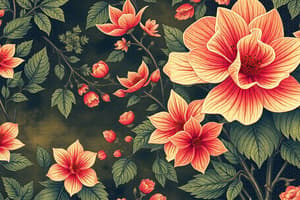Podcast
Questions and Answers
Which of the following statements correctly describes a phenolic compound?
Which of the following statements correctly describes a phenolic compound?
- It consists only of carbohydrates.
- It contains a carbon ring with multiple double bonds.
- It contains a benzene ring substituted with a ketone group.
- It contains a benzene ring substituted with a hydroxyl group. (correct)
Flavones are characterized by a double bond between positions 2 and 3 of the C ring.
Flavones are characterized by a double bond between positions 2 and 3 of the C ring.
True (A)
What is the systematic name of phenol?
What is the systematic name of phenol?
hydroxybenzene
Flavonols have a hydroxyl group in position ______ of the C ring.
Flavonols have a hydroxyl group in position ______ of the C ring.
Match the following flavonoids with their characteristics:
Match the following flavonoids with their characteristics:
What is the characteristic feature of flavanones?
What is the characteristic feature of flavanones?
Isoflavones resemble estrogens such as estradiol.
Isoflavones resemble estrogens such as estradiol.
What is the general formula of phenolic compounds mentioned?
What is the general formula of phenolic compounds mentioned?
Match the flavonoids with their descriptions:
Match the flavonoids with their descriptions:
Which flavonoid is also known as dihydroflavonols?
Which flavonoid is also known as dihydroflavonols?
Neoflavonoids are not considered polyphenolic compounds.
Neoflavonoids are not considered polyphenolic compounds.
This structural feature of flavonoids, the double bond between positions 2 and 3, is lost in ______.
This structural feature of flavonoids, the double bond between positions 2 and 3, is lost in ______.
Which group of flavonoids is characterized by having a hydroxyl group and might be glycosylated?
Which group of flavonoids is characterized by having a hydroxyl group and might be glycosylated?
Which of the following best describes a distinguishing feature of flavanones?
Which of the following best describes a distinguishing feature of flavanones?
Isoflavones have structural similarities to estrogens.
Isoflavones have structural similarities to estrogens.
The general formula for phenolic compounds is ______.
The general formula for phenolic compounds is ______.
Match each subgroup of flavonoids with its description:
Match each subgroup of flavonoids with its description:
Which flavonoid subgroup is recognized for having highly diversified and multisubstituted structures?
Which flavonoid subgroup is recognized for having highly diversified and multisubstituted structures?
Neoflavonoids are considered a subgroup of flavonoids.
Neoflavonoids are considered a subgroup of flavonoids.
In flavonols, the hydroxyl group appears in position ______ of the C ring.
In flavonols, the hydroxyl group appears in position ______ of the C ring.
What unique feature is associated with the B ring in isoflavones?
What unique feature is associated with the B ring in isoflavones?
Which structure is characterized by having a ketone in position 4 of the C ring?
Which structure is characterized by having a ketone in position 4 of the C ring?
What is the primary structure of phenol?
What is the primary structure of phenol?
All flavonoids contain a ketone group in their structure.
All flavonoids contain a ketone group in their structure.
Identify the class of compounds that is characterized by having structural similarities to estrogens.
Identify the class of compounds that is characterized by having structural similarities to estrogens.
Match the flavonoids with their corresponding descriptions:
Match the flavonoids with their corresponding descriptions:
Which subgroup of flavonoids does NOT contain a double bond between positions 2 and 3?
Which subgroup of flavonoids does NOT contain a double bond between positions 2 and 3?
Neoflavonoids are a category of polyphenolic compounds.
Neoflavonoids are a category of polyphenolic compounds.
What modification distinguishes flavonols from flavones?
What modification distinguishes flavonols from flavones?
Match each flavonoid with their unique feature:
Match each flavonoid with their unique feature:
Flashcards
Phenolic compound definition
Phenolic compound definition
A compound containing a phenol moiety, which is a benzene ring with a hydroxyl group.
Flavonoid subgroups (Flavones)
Flavonoid subgroups (Flavones)
A subgroup of polyphenolic compounds with a double bond between carbons 2 and 3, and a ketone at position 4 of the C ring.
Flavonoid subgroups (Flavonols)
Flavonoid subgroups (Flavonols)
A subgroup of flavonoids, similar to flavones but with a hydroxyl group (OH) at position 3 of the C ring.
Isoflavones (phytoestrogens)
Isoflavones (phytoestrogens)
Signup and view all the flashcards
Neoflavonoids
Neoflavonoids
Signup and view all the flashcards
Phenol Moiety
Phenol Moiety
Signup and view all the flashcards
Flavonoid General Formula
Flavonoid General Formula
Signup and view all the flashcards
Flavones
Flavones
Signup and view all the flashcards
Flavonols
Flavonols
Signup and view all the flashcards
Flavanones (Dihydro-flavones)
Flavanones (Dihydro-flavones)
Signup and view all the flashcards
Flavanonols (Dihydroflavonols)
Flavanonols (Dihydroflavonols)
Signup and view all the flashcards
Ruta Graveolens
Ruta Graveolens
Signup and view all the flashcards
Phenolic Compound
Phenolic Compound
Signup and view all the flashcards
Phytoestrogens
Phytoestrogens
Signup and view all the flashcards
What is a phenolic compound?
What is a phenolic compound?
Signup and view all the flashcards
What makes a flavonoid special?
What makes a flavonoid special?
Signup and view all the flashcards
Difference between flavones and flavonols?
Difference between flavones and flavonols?
Signup and view all the flashcards
What is the difference between flavones and flavanones?
What is the difference between flavones and flavanones?
Signup and view all the flashcards
What are flavanonols?
What are flavanonols?
Signup and view all the flashcards
What are isoflavones?
What are isoflavones?
Signup and view all the flashcards
Why are isoflavones called phytoestrogens?
Why are isoflavones called phytoestrogens?
Signup and view all the flashcards
What are neoflavonoids?
What are neoflavonoids?
Signup and view all the flashcards
What is Ruta Graveolens?
What is Ruta Graveolens?
Signup and view all the flashcards
What is the difference between flavones and flavanonols?
What is the difference between flavones and flavanonols?
Signup and view all the flashcards
Study Notes
Flavonoids
- Flavonoids are a class of polyphenolic secondary metabolites found in plants.
- Humans commonly consume them in their diet.
- Flavonoids have the general formula (C6 -C3 - C6).
- Phenolic compounds contain a phenol moiety.
- Phenol is a benzene ring substituted with a hydroxyl group.
- The systematic name for phenol is hydroxybenzene.
Chemical Classification of Natural Phenolic Compounds
- Phenolics are categorized into simple phenols, polyphenols, flavonoids, and non-flavonoids.
- Phenolic acids include hydroxycinnamic acids (e.g., caffeic acid, p-coumaric acid, ferulic acid) and hydroxybenzoic acids (e.g., gallic acid, protocatechuic acid).
- Coumarins include coumarin, psoralen, scopaletin, and esculetin.
- Flavonoids include flavones, flavonols, flavanones, flavanols, isoflavonols, anthocyanins, and chalcones.
- Non-flavonoids include tannins, lignans, and stilbenes.
Flavonoid Classification
- 1-Flavones have a double bond between positions 2 and 3 and a ketone in position 4 of the C ring.
- 2-Flavonols have a hydroxyl group in position 3 of the C ring, which can be glycosylated.
- 3-Flavanones have a saturated C ring, and the double bond between positions 2 and 3 is absent.
- 4-Flavanonols are 3-hydroxy derivatives of flavanones.
- 5-Isoflavones have the B ring attached to position 3 of the C ring and are structurally similar to estrogens (phytoestrogens).
- 6-Neoflavonoids are a class of polyphenolic compounds.
Pharmacological Effect of Flavonoids
- Flavonoids have various pharmacological effects including:
- Anti-oxidant
- Anti-inflammatory
- Immune defense
- Anti-microbial
- Anti-mutagenic
- Anti-carcinogenic
- Anti-hepatic
Example Flavonoids
- Quercetin
- Kaempferol
Studying That Suits You
Use AI to generate personalized quizzes and flashcards to suit your learning preferences.




